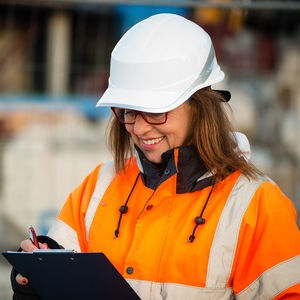05.F High-Visibility Apparel.
05.F.01
High-visibility apparel meeting, at minimum, ANSI/ISEA 107, Performance Class 2 requirements, must be worn by workers (i.e., signal persons, spotters, survey crews, inspectors, etc.) whenever:
- There is limited visibility of workers exposed to mobile/heavy equipment operations, vehicles, load handling, or other hazardous activities;
- Reduced visibility conditions exist due to weather conditions, illumination, or visually complex backgrounds where ambient visibility is at least 50 ft (15.2 m); OR
- Workers are exposed to vehicular or equipment traffic at speeds up to 35 mph (56.3 kph).
05.F.02
If any or all of the following conditions exist, Class 3 high-visibility apparel meeting ANSI/ISEA 107 must be worn for higher visibility (i.e., signal persons, spotters, survey crews, inspectors, etc.) whenever:
- Reduced visibility conditions exist due to weather conditions, illumination, or visually complex backgrounds where ambient visibility is less than 50 ft (15.2 m);
- Workers are exposed to vehicular or equipment traffic in excess of 35 mph (56.3 kph);
- Workers are performing tasks which divert attention from approaching vehicular traffic, traveling in excess of 35 mph (56.3 kph), as posted; OR
- Workers are involved in activities in close proximity to vehicular traffic with no protective barriers.
05.F.03
When working at night, on or near sites where vehicles are present, workers (i.e., signal persons, spotters, survey crews, inspectors, etc.) must wear, at a minimum, a Class 3 high-visibility safety coverall/jumpsuit or a Class 3 high-visibility safety jacket and Class E high-visibility pants, or bib overalls.
05.F.04
If the use of high-visibility apparel proves to create a greater hazard due to moving machinery, pinch points, heat stress or other reasons, an AHA detailing rationale for infeasibility of use and alternate safety measures to be used to ensure same level of worker safety, must be developed, signed and submitted by the responsible person and accepted by the GDA, supervisor or the command's local Safety and Occupational Health Office (SOHO). Work must not commence until such acceptance has been obtained.
05.F.05
The apparel background material color must be either fluorescent yellow-green, fluorescent orange-red, or fluorescent red (see ANSI/ISEA 107). When choosing color, optimization of color conspicuity between the wearer and work environment must be considered.
05.F.06
The apparel must be:
- Free of roughness, sharp edges and projections that could cause irritation or injury;
- Should fit correctly to ensure that the vest remains in place for the expected period of use, environmental conditions, and wearer movements;
- Cleaned, laundered and/or dry-cleaned in accordance with the label located on the apparel;
- In useable condition with limited rips, tears or fading; and
- Replaced if it fails to comply with and of the above or ANSI/ISEA 107.
Knowledge Check Choose the best answer for the question.
5-8. When is Class 3 high-visibility apparel required for signal persons, spotters, survey crews, inspectors, etc.?
You forgot to answer the question!

